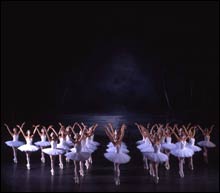 Touring is a way for a ballet company to make a name for itself, but you make it harder when you can’t decide on the name. The Tchaikovsky Ballet and Orchestra, which last week brought The Sleeping Beauty and Swan Lake to the Majestic Theatre, was in the Soviet era known as the Perm State Ballet. Its current aliases include the Tchaikovsky Perm Ballet and Orchestra and the Tchaikovsky Perm State Ballet Theatre, the company hoping that the Tchaikovsky name will draw those for whom Perm might smack of the provinces. (It’s in the Urals; Tchaikovsky was born in near-by Votkinsk.) By any name, the Perm folks are on a two-month US tour with the two Tchaikovsky classics. The thinking is that Americans won’t flock to see anything less; the catch is that the company can’t afford, or expect to fill, big houses like the Wang Theatre, so it’s left with small ones like the Majestic (where the Russian National Ballet performed Swan Lake last April) with cramped stages that display neither the dancers nor the works at their best.
Touring is a way for a ballet company to make a name for itself, but you make it harder when you can’t decide on the name. The Tchaikovsky Ballet and Orchestra, which last week brought The Sleeping Beauty and Swan Lake to the Majestic Theatre, was in the Soviet era known as the Perm State Ballet. Its current aliases include the Tchaikovsky Perm Ballet and Orchestra and the Tchaikovsky Perm State Ballet Theatre, the company hoping that the Tchaikovsky name will draw those for whom Perm might smack of the provinces. (It’s in the Urals; Tchaikovsky was born in near-by Votkinsk.) By any name, the Perm folks are on a two-month US tour with the two Tchaikovsky classics. The thinking is that Americans won’t flock to see anything less; the catch is that the company can’t afford, or expect to fill, big houses like the Wang Theatre, so it’s left with small ones like the Majestic (where the Russian National Ballet performed Swan Lake last April) with cramped stages that display neither the dancers nor the works at their best.
Perm’s artistic director is at least familiar to Boston: Natalia Akhmarova was a principal dancer with Boston Ballet in the mid ’90s. She took over in Perm in 2002, but the individual flair with which she danced in John Cranko’s Onegin and Michael Corder’s Cinderella hasn’t yet infused the company’s Sleeping Beauty, which looked stagebound, stately and sleepy and a little stolid. The period wigs didn’t help; when Anna Poistogova as Red Riding Hood came on with her own brown hair visible under the babushka, it was if the entire ballet had been kissed and awakened. Natalia Moiseeva brought a toothy, inquisitive smile to Aurora, and her Rose Adagio was as solid as the Statue of Liberty. But everything was presented rather than performed: all those tall, long-legged women bespoke tableaux more than technique, and manèges had as much on-stage content as John Cage’s 4:33.
Swan Lake was better. The 24-member swan corps negotiated the space with aplomb, the long arms and legs made their ensemble that much more gratifying, and the big swans were unusually quiet. Elena Kulagina, the Dancing Girl in the Perm State Ballet’s 1992 Don Quixote video (with Nina Ananiashvili as Kitri/Dulcinea), gave Odette/Odile the speed and flow that were missing from Beauty. Less storybook swan than young woman, her Odette sized up her Siegfried (Alexey Tyukov) not as a handsome prince but as a young man she was attracted to; her Odile was bad-girl tempting and hit all 32 fouettés on the beat. The opening scrim suggested Rothbart’s triangular face before the lighting dissolved it into design; the orchestra under Valery Platonov managed the upbeat Mazurka better than the Kirov Orchestra did in its 2002 Swan Lake in Lincoln Center. Only the ending puzzled and disappointed, the swans not evidently freed (what else is the music’s B major for?), Odette and Siegfried embracing in a dark limbo.
During intermissions at the Majestic, the language of choice was Russian. There are many places in America where you wouldn’t otherwise see Tchaikovsky ballets done this well; Boston just isn’t one of them. But Perm’s Swan Lake was well ahead of the one the Russian National Ballet brought, and I could watch it again.